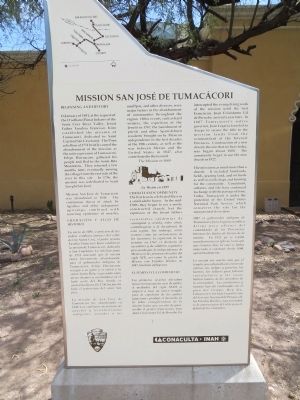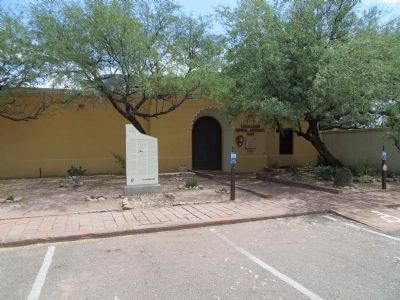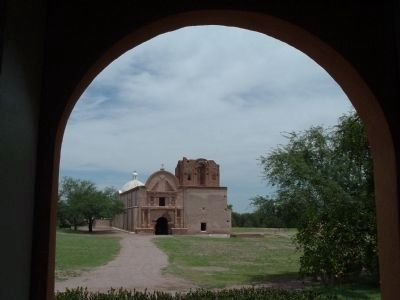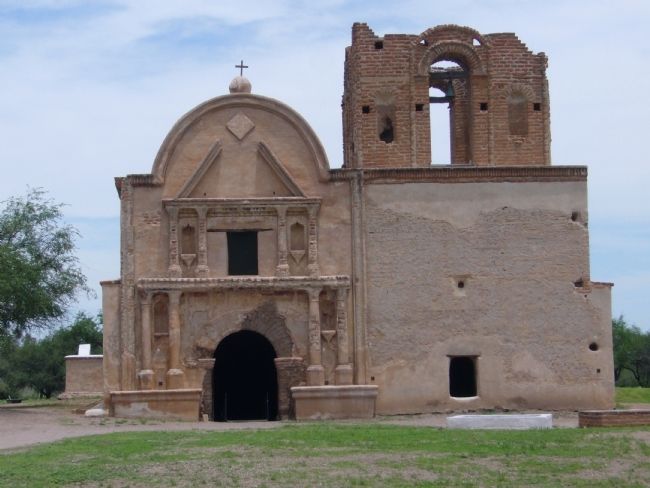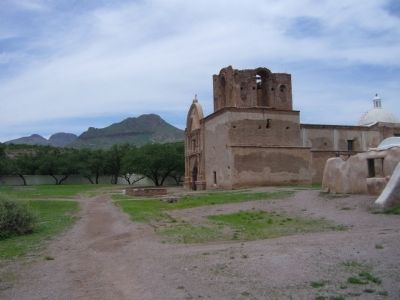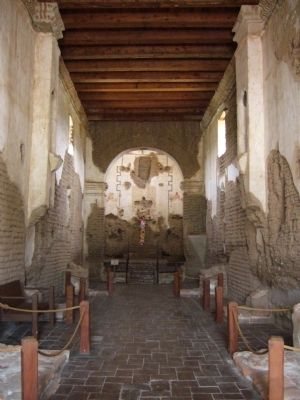Tumacacori in Santa Cruz County, Arizona — The American Mountains (Southwest)
Mission San José de Tumacácori
Beginning and History
In January of 1691, at the request of the O'odham (Pima) Indians of the Santa Cruz River Valley, Jesuit Father Eusebio Francisco Kino established the mission of Tumacácori, dedicated to Saint Cajetan (San Cayetano). The Pima rebellion of 1751 briefly caused the abandonment of the mission, as the native governor of Tumacácori, Felipe Huvuacam, gathered his people and fled to the Santa Rita Mountains. They returned a few months later, eventually moving the village from the east side of the river to this site. In 1756, the mission was rededicated to Saint Joseph (San José).
Mission San Jose de Tumacácori was abandoned in 1848. The continuous threat of attack by Apaches and other indigenous uprisings, combined with recurring epidemics of measles, smallpox, and other diseases, were major factors in the abandonment of communities throughout the region. Other events, such as hard winters, the expulsion of the Jesuits in 1767, the banishment of priest and other Spanish-born residents brought on by Mexican independence in the first decades of the 19th century, as well as the war between Mexico and the United States in 1847, also contributed to the turmoil.
Church and Community
The first Jesuits celebrated Mass in a small adobe house. In the mid 1700's they began to use a newly constructed church, but the expulsion of the Jesuit fathers interrupted the evangelizing work of the mission until the first Franciscan, Juan Crisóstomo Gil de Bernabe, arrived a year later. In 1807 Tumacácori's native governor, Juan Legarra, traveled to Arizpe to secure the title to the mission lands from the commandant of the Internal Provinces. Construction of a new church, the one that we have today, was begun about 1800. The community began to use the new church in 1822.
The mission was much more than a church. It included farmlands, fields, grazing land, and orchards as well as workshops and housing for the community. Conditions, cultures, and life have continued to change with the passage of time. Today, Tumacácori is under the protection of the United States National Park Service which conserves the site for the enjoyment of its visitors.
Fundación y Algo de Historia
a En enero de 1691, a petición de los indios o'odham (pimas) del valle del río Santa Cruz, el padre jesuita Eusebio Francisco Kino estableció la misión de Tumacácori, dedicada a San Cayetano. La rebelión pima de 1751 ocasionó que la misión fuera brevamente abandonada, pues el gobernador indígena de Tumacácori, Felipe Huvuacam, recogió a su gente y se retiró a la sierra Santa Rita, regresando unos meses después y asentándose en el lado oeste del Río, donde se encuentra ahora. En 1756 fue puesta bajo el patrociion del señor San José.
La misión de San José de Tumacácori fue abandonada en 1848. La continuas incursiones de apaches y levantamientos indígenas, aunados a las recurrentes epidemias de sarampión y viruela, entre otras, contribuyeron a la decadencia de esta región. Sin embargo, otros eventos como las inclemencias de los inviernos, la expulsión de los jesuitas en 1767, el destierro de sacerdotes y de súbditos españoles provocado por la independencia de México en las primeras décadas de siglo XIX, así como la guerra de México con Estados Unidos en 1847, también influyeron.
El Tiempo y la Comunidad
Los primeros jesuitas oficiaban misa en una pequeña casa de adobe. A mediados del siglo XVIII se empezó a usar un nuevo templo, pero la expulsión de los padres ignacianos produjo el descuido en la labor evangelizadora de la misión hasta que, un año después, arribó el primer franciscano, fray Juan Crisóstomo Gil de Bernabé. En 1807 el gobernador indígena de Tumacácori, Juan Legarra, acudió a Arizpe para obtener del comandante de las Provincias Internas los títulos de tierras de la misión. En 1822 ya se estaba usando una nueva iglesia, la misma que tenemos hoy, la cual se había empezado a construir desde 1800, aproximadamente.
La misión era mucho más que el templo, pues abarcaba las tierras de cultivo, las milpas y parcelas, las huertas, los talleres para fabricar satisfactore y las casas habitacionales de los miembros de la comunidad. Las condiciones y tamaño han ido cambiando con el paso del tiempo. Hoy día, Tumacácori esta bajo la protección del Servicio Nacional de Parques de los Estados Unidos, cuya prioridad es la conservación del sitio para el deleite de los visitantes.
Captions:
The Mission in 1889.
La Misión en 1889.
Erected by National Park Service, Conacultura - Inah.
Topics and series. This historical marker is listed in these topic lists: Churches & Religion • Native Americans • Settlements & Settlers. In addition, it is included in the Juan Bautista de Anza National Historic Trail, and the National Historic Landmarks series lists. A significant historical month for this entry is January 1691.
Location. 31° 34.069′ N, 111° 3.074′ W. Marker is in Tumacacori, Arizona, in Santa Cruz County. Marker is on East Frontage Road, on the right when traveling north. Tumacácori National Historical Park is located off of Exit 29 of Interstate 19, fifty miles south of Tucson, Arizona. Touch for map. Marker is at or near this postal address: 1891 East Frontage Road, Tumacacori AZ 85640, United States of America. Touch for directions.
Other nearby markers. At least 8 other markers are within 3 miles of this marker, measured as the crow flies. Tumacacori Museum (a few steps from this marker); Tubac (approx. 2.8 miles away); Baca Float Number 3 (approx. 3 miles away); Juan Bautista de Anza (approx. 3.1 miles away); Presidio of Tubac (approx. 3.1 miles away); Charles Debrille Poston (approx. 3.1 miles away); Tubac Presidio (approx. 3.1 miles away); Tubac Schools (approx. 3.1 miles away).
Also see . . .
1. Tumacácori National Historical Park. Tumacácori National Historical Park is located in the upper Santa Cruz River Valley of southern Arizona. The park protects the ruins of three Spanish mission communities, two of which are National Historic Landmark sites, and it also contains the Tumacácori Museum, a historic landmark building built in 1937 that is also a National Historic Landmark. (Submitted on August 29, 2013, by Bill Kirchner of Tucson, Arizona.)
2. Kino Heritage Society. (Submitted on December 2, 2019.)
3. NPS: San José de Tumacácori. (Submitted on December 2, 2019.)
Credits. This page was last revised on December 2, 2019. It was originally submitted on August 27, 2013, by Bill Kirchner of Tucson, Arizona. This page has been viewed 751 times since then and 20 times this year. Photos: 1, 2, 3, 4, 5, 6. submitted on August 27, 2013, by Bill Kirchner of Tucson, Arizona. • Syd Whittle was the editor who published this page.
